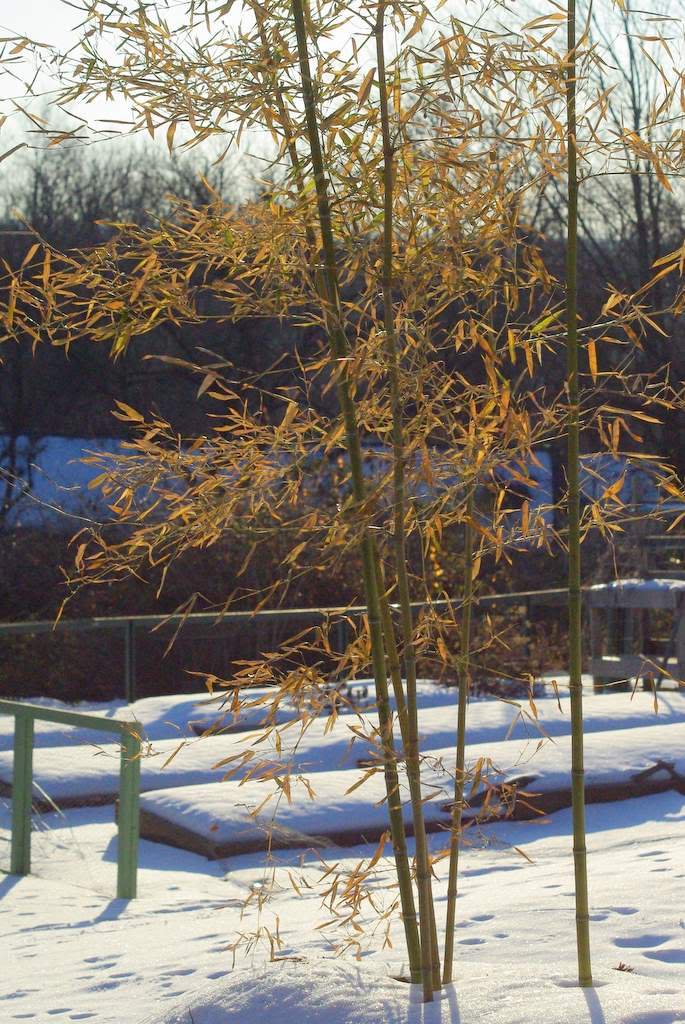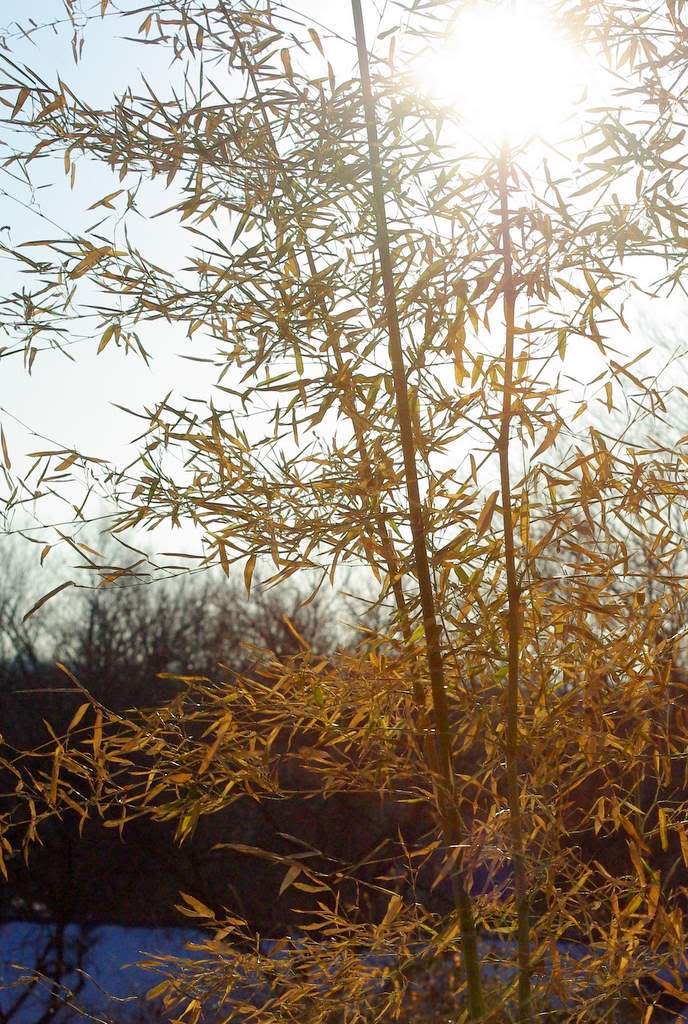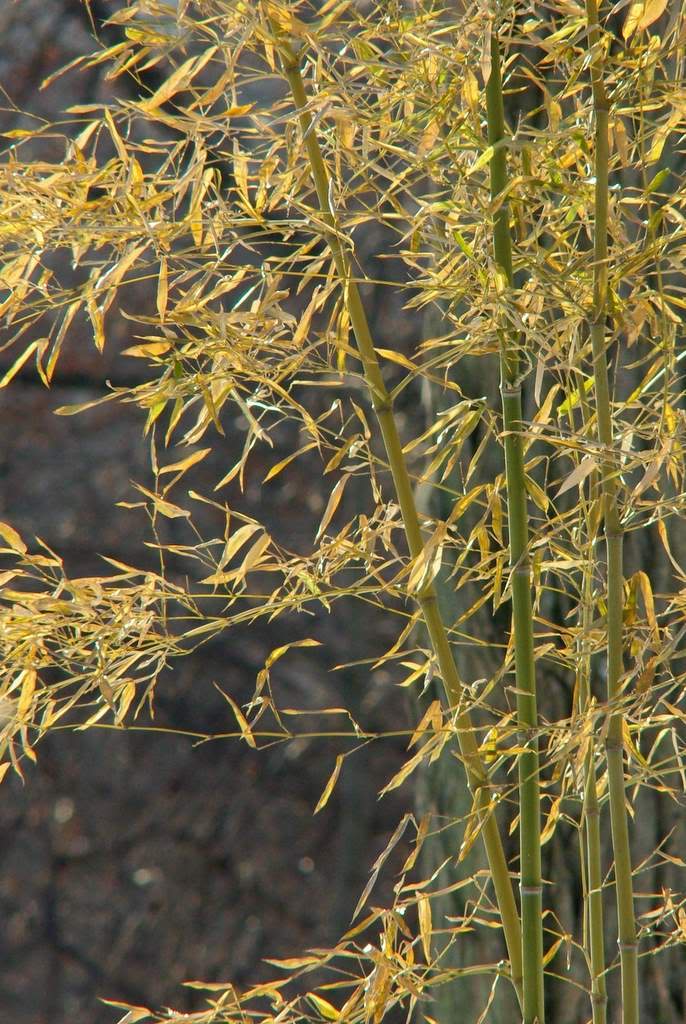As the temperature takes a turn toward the top of the thermometer for the next week, it's time to start thinking about the plants that might have suffered a bit this winter. I'm not saying that spring is here and we won't have any more cold days, because we will. Our last frost date is around May 7th from what I remember, and a few years back we had several days in mid-April where it got into the mid 20's F for three nights in a row. I'm just saying that during a warm spell a gardener can't help but get outside and take a look around the garden.
For those of us who grow bamboo in cold climates (or even warm climates, based on the weather they've had recently in Texas and other southern states) winter is a nervous time. Our goal with growing large bamboos is to get them to their mature large state, which isn't always easy where it's cold.
Different species of cold-hardy bamboos have different levels of cold tolerance -- like all plants. The first thing to go when the temperatures dips below a bamboo's cold-tolerance level is the leaves.
They'll dessicate or "burn" as we like to say, and will later turn light brown, the color of a dead bamboo leaf. Sometimes only a few leaves on a plant will burn, or only parts of leaves will. In this case it looks like every single leaf is dead.
Since we want these plants to size up every year (produce larger, taller culms), ideally the plant would keep all of its leaves through the winter -- green leaves mean more food production for growing new culms. There are several plants in my yard that still have green leaves. This is not one of them obviously. Since this is one of the more cold-hardy species (Phyllostachys atrovaginata) I think its cold-intolerance is due to the fact that it was just planted last summer. These plants can take a few years to start showing their full cold hardiness.
Seeing blonde leaves doesn't mean the plant is dead though. Hopefully the leaf buds are undamaged, which means that this plant will produce all new leaves in the spring. If the leaf buds were damaged by the cold, then we have what we call "top kill" -- the above ground parts of the plant are dead. (Seeing green culms doesn't really mean anything at this point -- without leaves the culms will eventually die.) Even with top kill the plant itself is not dead though, since the underground rhizomes will still produce new culms when it warms up -- they just probably won't be as large as the existing culms. Smaller is not good -- we want bigger culms!
So that's why bamboo growers watch the weather forecasts so closely all winter, and monitor the low temperatures (and other conditions) our plants are exposed to. We're concerned about our plants suffering too much damage, and we're interested in finding out just how cold it has to get to damage different species.
As attractive as this color combination is, I don't like seeing this plant with leaves of this color.
On the bright side, now I've just got something else to look forward to this spring. Instead of checking the plant every day only for signs of emerging shoots, I'll also be checking it for signs of swelling leaf buds.
Only when I see those will I be able to relax and fully enjoy the onset of spring.





Sobering images. Is this your only bamboo that suffered leaf burn? How are the others doing--I know you mentioned some still having green leaves.
ReplyDelete:: Bamboo and More ::
Thanks for the update. I just checked the stuff that is sticking out of the snow and despite nearly complete leaf burn on some of them, I found viable buds on atro, YG, Rubro, Bissetii, Parv and Dulcis even on the branches that were exposed to the -9F with wind-chills that were probably close to -20F on that night.
ReplyDeleteThey look destroyed with some of them over 90% leaf burn, but I'm a bit surprised that these bamboos can make it through one of the worst winters in this climate. Many of them that had exposed culms over the major freezes will probably be set back a bit since they can't produce energy right away, but I'm expecting them all to still upsize given that they really didn't top kill.
Some of the buds on the extremities flicked off, but most of them were intact, and it looks like moso is the only bamboo that sustained culm damage, so I wouldn't recommend it for your zone given you get less snow. After brushing away some snow, it looks like some of my moso seedlings were still fried despite the snow protection.
Gerhard - it's the only Phyllostachys that burned completely. All of the others have some, although Phy. glauca 'Yunzhu' is pretty fried too.
ReplyDeleteSteve - I already decided not to bother with moso. I'm also not sure of my ability to tell a viable leaf bud this early. I'll wait until they start to swell rather than guess what will happen.